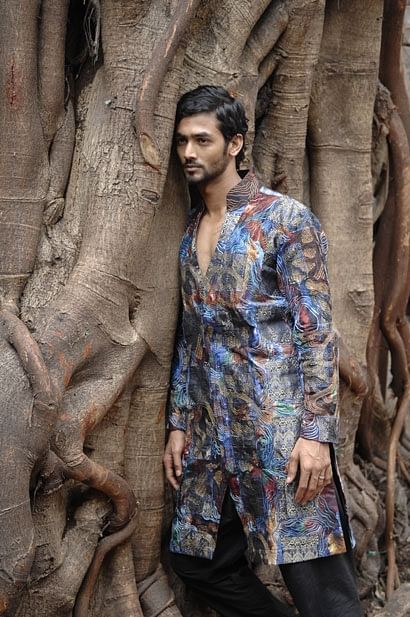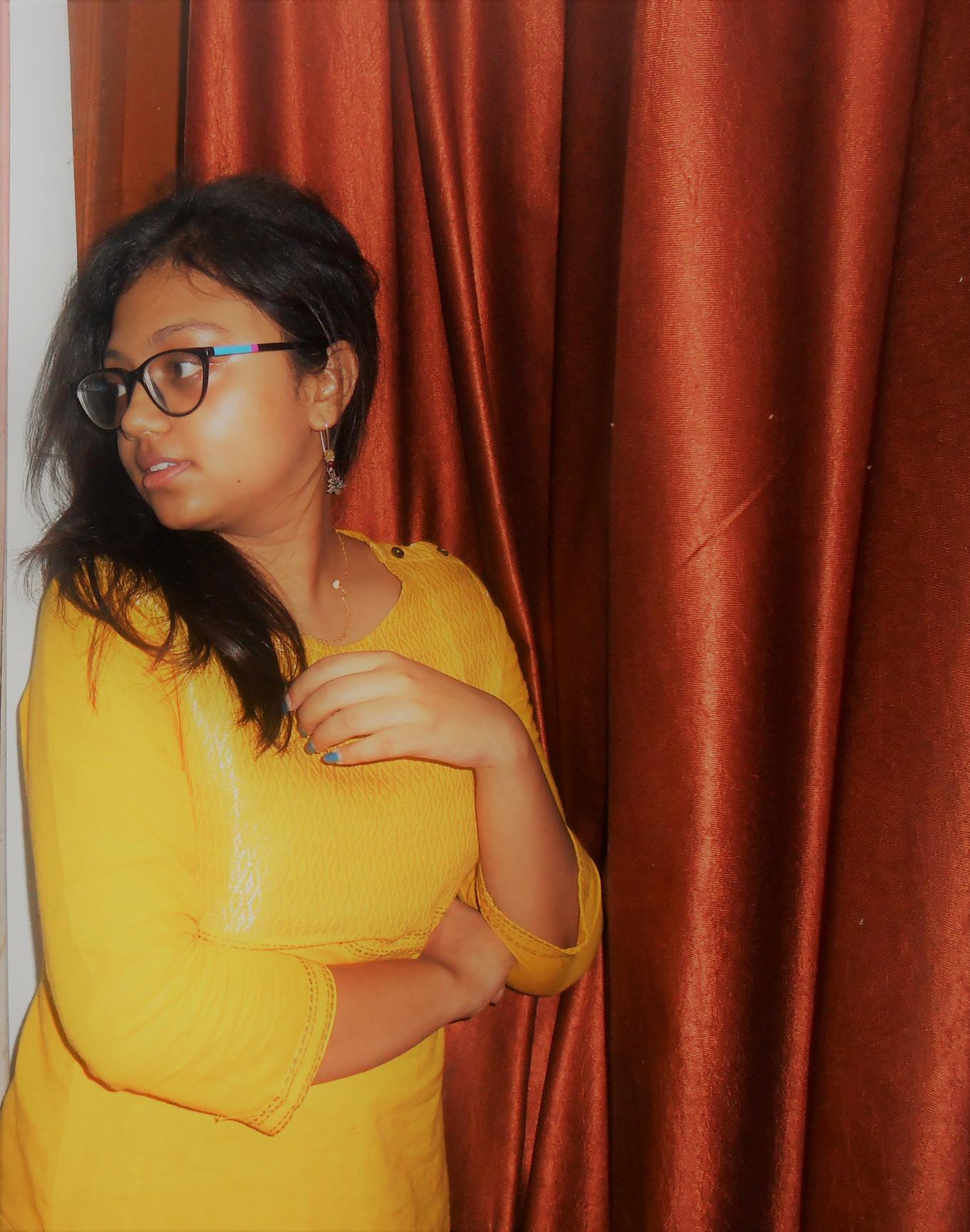Sharbari Studio, driven by the indomitable spirit of creativity and a desire to create its own niche, started in 1991. With constant brainstorming, Sharbari, Amalin, and daughter-in-law Kanaklata realized a gaping hiatus in the area of men's fashion. The trio cultivated its knack for art and aesthetics and dabbled into the fashion industry, creating a buzz with its dynamic kurtas & colored dhotis. Sharbari Studio brought traditional Indian wear into the mainstream. They revived & popularised ethnic wear that changed the scenario in the Indian fashion industry. The design studio is the personification of urban contemporary and is responsible for bringing what is currently known as men's fashion. The studio, through its personalized philosophy of fashion, created a distinctive line of men's celebration wear.
40/1A, Broad St, is often referred to as "studio", for its design is often labeled as "artwear" as opposed to "fashion wear". The fabric is its canvas wherein the creators let their aesthetic imagination take shape into reality. The brand has exposed the traditional wealth of Indian costumes, which gives each piece of creating a contemporary edge. That squares with a modern men's wardrobe. The brand has revived Bengali culture, tradition, and heritage as the studio has rediscovered and pioneered the traditional attire with a modern outlook. In this post-modern age of changing values, Sharbari Studio is influencing the taste and has set the bar high for men's designer wear. This bespoke brand takes pride in its creative soul and how it has nurtured its imagination & inspiration and enlivened every piece of fabric lively with utmost care.
The brand focused on customer satisfaction, which in turn, has garnered a vast base of patrons that kept on growing with each passing day. Sharbari Studio never wanted to be a part of the rat race in the fashion industry. It did not participate in every fashion show or changed its business model in a retail franchise to become famous all across the country. Rather, it chooses to operate from it backyard, the inception place of the brand, and it wants the world to come to them. And it has!
Having completed three decades in this extremely dynamic fashion world, the studio's trend of creating garments for men, with an inventive fusion of different traditional designs, has always rendered timeless pieces.
The elaborate motifs of a bygone era of leisure and pleasure were coming back with a vengeance in their clothes. Cave and folk art, Egyptian mural, calligraphy of West and East Asia, pop art, and Hindu mythology were sources of inspiration for the leading brand. Hand embroidery over hand-stitched motifs that drew inspiration from rustic and folk culture as the mainstay, Sharbari Studio became the go-to place for Calcutta men for their wedding outfits, who never before dared to don the brightly colored dhoti that the brand first introduced. Breaking the norms of a beige or white piece of traditional drape, it broke free from a monotonous world of stripes and checks and became a celebration of swashbuckling masculinity. The studio has been stitching fusion and spinning originality that gives hues to their roots. Its sole point was to establish the fact that there is no clash between masculinity and bright colors.
Progressive in their thoughts, the brand paved the path for the upcoming generations of men to look up to their fashion sense, irrespective of what color they don, as long as they are confident and comfortable. The brand's march towards modernity has neither affected the traditional looms nor the weaving techniques. It has set a high benchmark in reviving techniques of a particular region and fusing art and fashion.
It took "Katha", often considered one of the ancient embroidery forms, and revived & refined it into something extraordinary. The studio's labor of love is continued by her son Amalin and daughter-in- law Kanaklata with the same love and care after the sad demise of Sharbari Datta.
THE JOURNEY SINCE 1991
Sharbari Studio started its journey with "Purono Kolkata", organized at the Conclave, Kolkata 1991. It was a subdued affair with close friends and family, as it was apprehensive of not being applauded and appreciated. There were no media, press, or models. Just some handmade mannequins made of hay and straw. But, all the products on display were sold off.
The unanticipated response in their first exhibition was an eye-opener to them. It was time to invite media and take the small family business global. In 2007, the brand was assigned with the country's most happening wedding - the marriage of Abhishek Bachchan & Aishwarya Rai Bachchan. The brand officially got the opportunity to clad the groom and other men for the ceremony. This paved new ways for the studio as in 2008, Al Gore was presented with its achkan on the eve he won the Nobel Peace Prize.
The brand's clientele list reads like a veritable who's who! From M.F Hussain and Ustad Amjad Ali Khan to Sourav Ganguly and Sunil Gavaskar, numerous celebrities have turned up unannounced and lauded the work. The brand believes in a graceful flow without compromising the masculinity aspect. Presently, Kanaklata is managing Sharbari Studios with Amalin Datta and continuing the rich legacy.
Sharbari Studio has dressed many icons across the globe for the past three decades. Very few even dare to dream about the milestones the brand has achieved. From Sunil Gavaskar and Leander Paes to Akshay Kumar and Ismail Merchant, numerous personalities have dressed up in the brand's design. It was a particular moment for the brand when painter M.F Hussain dropped by their Broad Street store and sought the brand out for two exclusive kurtas. Since then, renowned Indian painters like Ganesh Pyne, Manjit Bawa, Paresh Maity, etc., have bought the studio's designs and become regular patrons. Indian National Football Team captain Bhaichung Bhutia has collections from Sharbari Studio in his wardrobe. Maestro Ghazal singer Jagjit Singh has dropped by unnoticed in their Broad Street outlet and chose a couple of Punjabi suits.
The brand has also designed costumes for two films of Rituparno Ghosh - "Chokher Bali" featuring Aishwarya Rai Bachchan, based on Tagore's novel, and "Antarmahal". The maestro wore Sharbari Studio's curated design during each award ceremony, where he was felicitated. He even received his "Dadasaheb Phalke Award" in a Sharbari Studio designer wear. Another feather in the brand's cap was added when CM Mamata Banerjee assigned Sharbari Studio the work of Kantha Stitch sherwanis and Galabands. The creations were used to felicitate guests at the Kolkata International Film Festival. Amitabh Bachchan, Shah Rukh Khan, and Kamal Hassan were felicitated with Sharbari Stidio's artwear at the inaugural ceremony.
Sachin Tendulkar was presented with a royal silk sherwani in his last match at Eden Gardens that was exclusively designed by Sharbari Studio.
It was a usual afternoon at 40/1A Broad Street when daughter-in-law Kanaklata Datta was taken by surprise. One of the first celebrities who came by was Ismail Merchant. He had seen their work and loved them and decided to customize a few of his attires. Sharbari Studio designed subtle and sober stuff for him. Sunil Gavaskar & his wife Marshneil came by their house, and they completely humbled the designers when the legendary cricketer exclaimed, "You are famous, and I have heard of you." This particular incident was a big boost for it acted as a springboard. The studio has also designed for Kapil Dev, Shoaib Akhtar, Imran Khan, and so on. Kishore Bhimani, the veteran sports journalist, had a special place in his heart for this Kolkata brand. For his first 200 quiz shows on TV, he only ore Sharbari Studio's fabulous Kurtas. It was at that moment that this Kolkata brand outwitted Mumbai/Delhi designers. Post the telecasts, Leander Paes and other hobnobs became curious. Sharbari Studios have successfully infiltrated the elite crown of the Bollywood and sports field. Indian politician Sovan Chatterjee landed up at Sharbari Studio for he was at his wits end about what to wear at "Didir barir kali pujo" He was presented with a beautiful sherwani in "Mayurpankhi" colors that fitted him perfectly. As per his own words, "When I wore it in the evening, 'shobai obaak hoye gechhilo". (Even my wife was surprised, and so was Didi.)
The magic this brand knits and embroiders is everlasting and beyond admiration. For it knits future, it knits culture, tradition, heritage, and juxtaposes its world with the right amount of contemporary that gives each collection a perfect edge.
Kolkata is a city of paradoxes. On one side, it boasts of colonial architecture, and on the other, there are compact apartments that are the size of matchboxes. Every home, large or small, majestic or minimalistic, has its own story to tell. These stories provide a peek into the lives of the people who turn an address into a home.
An artistic abode, 40/1A Broad Street, has been the nerve center since the early 70s. The humble house of Alo Datta & Sharbari Datta is an antique house. Alo Datta was a creative man. He had his own brand of hand-printed silk sarees in the seventies, which was very popular among the elite and fashionable ladies at that time. Lady Ranu Mukherjee was a frequenter. Sharmila Tagore wore his creations in the film "Amanush".
The property has always been an art hub. The leafy bower that extends to visitors doubles up as their studio-cum-store. This is where they ideate, curate, meet their clients, sell their designs, cook, and live. The house is tucked away in a corner of Broad Street, crammed with antique pieces and finely crafted murals. it is immediately identifiable as a vibrant pink mural of Lord Ganesha adorns the entrance.
The living room has a low sitting arrangement on a block of marble where the clients can sit and chat before entering an alcove for trials. The clients are provided with a feel-at-home factor, for that is what the studio is all about - customer satisfaction.
Having a muralist in the family surely helps. But having two muralists is even better. Amalin Datta picked up his father's art and dedication to murals from a very young age. The "Radha Krishna" mural grabs eyeballs, and their sitting area is done with the ceiling painted with images from "Raas Leela".
One of the most striking pieces of antique furniture is the four-poster bed. The piece was used in the film "Iti Mrinalini". Now, the vertical beams of the bed have been dismantled to decorate the doorway to the dining room.
There is no dearth of antiques in their home. From brass utensils and wooden furniture to floral motifs covering the walls, the house is unique, and each room has its individual style. Old tree trunks that are curved and stylized into human figures to stone sculptors - the studio is a perfect amalgamation of art and antiques. The pantry door that opens out to the living room is camouflaged with a fresco from the Old Testament, painted by artisans of Amalin Datta's studio. Each wall is distinguished from one another. Replicas of Ajanta frescoes are juxtaposed with the mural's vibrant shades of red and blue. Ornate dark wooden furniture contrasts sharply with ceramic jars from Madhya Pradesh.
Their home boasts of holding "ashor" for notable persons like Sunil Gangopadhyay, Shakti Chattopadhyay, etc. Evening tea sessions used to take the ambiance by storm as it was an ensemble of cultural, poetic, and literary debts. A house that has carefully preserved the true essence of "Bangaliyani" mixed with other cultures from across the country can be nothing but a humble artistic abode. It gave wings to ideas that took Bengali ethnic wear to a global standard.
This is what has been the journey of the brand Sharbari since 1991, and it is all set to turn 30 this year.


